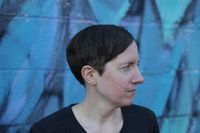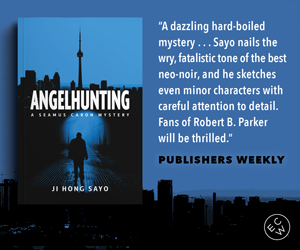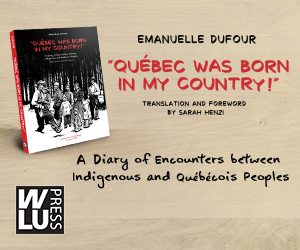Kim Trainor on Capturing Both a Tattooed Iron Age Woman & Modern Day Trauma in Her Book Length Poem
In 1993, a Russian scientist discovered the mummified remains of an Iron Age Pazyryk woman. She was covered in tattoos and buried with great ceremony. During the complex and difficult excavation, the scientist gave the woman the nickname "Ledi", which means "Lady" in Russian.
Fascinated by this story, Kim Trainor found herself sitting down to write a long poem about Ledi. But as she wrote, she found that it was about more than the mysterious Iron Age woman, and that parts of her own life, in particularly the death of a former lover by suicide, were weaving into Ledi's story - a kind of excavation of both the near and distant pasts together. The result is Ledi (Book*hug), a stunning, haunting, and powerful book-length poem.
We're excited to welcome Kim to Open Book today to tell us about her book and her process as part of our Lucky Seven series.
She tells us about how her project evolved from being all about Ledi to a more raw and personal angle, about writing the book in Vancouver's busy libraries, surrounding by people, and how great books are the ones that "tell us something we need to know".
Open Book:
Tell us about your new book and how it came to be.
Kim Trainor:
I had been wanting for a long time to write about Ledi, an Iron Age horsewoman whose ice-bound grave was found in the Siberian steppes in the early 90s. “Ledi” means “the lady” in Russian, and was the nickname given to her by the archaeologists. She had blue tattoos of leopards and griffins and deer on her shoulders and arms, and had been buried with her horses, along with many grave goods. We know all this because of the excavation, which in itself was inevitably a violent process. At first, I thought the poem—which I knew I wanted to be a long narrative poem—would focus exclusively on this woman. But when I actually sat down to write, instead of writing about her, I began to write short journal entries about a relationship I had when I was an undergrad at UBC; while we were together he had attempted at one point to take his own life, and then many years later I learned he had tried again, and succeeded. Once I realized this would become the heart of the poem, I wrote very quickly: journal fragments interspersed with notes on my research into the excavation of Ledi’s grave and the Pazyryk culture to which she belonged, inventories that catalogued the material artefacts and violent practices of both Iron Age cultures and our own. The vulnerability of Ledi, her exposure and the dismantling of her grave, began to function for me as an analog for the excavation of memory, especially as it relates to traumatic experience.
OB:
Is there a question that is central to your book, thematically? And if so, did you know the question when you started writing or did it emerge from the writing process?
KT:
I can’t say I had a specific question in mind; it is more that I felt a deep affinity for Ledi.
OB:
Did this project change significantly from when you first started working on it to the final version? How long did the project take from start to finish?
KT:
Perhaps it was gestating for years, but the poem as it now appears I wrote in about two weeks, a few hours each day, with the exception of “Ghost”, which I wrote two years later, again over the period of perhaps a week or two while participating in the 2016 Writing Studio at the Banff Centre for the Arts.
Your CanLit News
Subscribe to Open Book’s newsletter to get local book events, literary content, writing tips, and more in your inbox
OB:
What do you need in order to write – in terms of space, food, rituals, writing instruments?
KT:
I’m sort of a nomad when it comes to writing. I don’t have a writing desk as I live in several places, and I can’t bear to write holed up in a room on my own. I like to be out in a busy place, like a park, a campsite, or a pub or open communal space where there is background noise and activity and life going on. These locations then become part of the poem I’m working on. So much of Ledi was written either in the learning commons at UBC, this echoing cavernous space where the card catalogue used to be kept in the old Main Library, or in the Mount Pleasant library in East Van with a view out onto Main street, right at the intersection of Main and Kingsway. The section called “Ghost” I wrote much later, in Banff; it was agonizing to write in my room so mostly I would get up very early in the morning with my notebook and go to the Maclab Bistro, which has a view out to the mountains. I always write in small soft-cover notebooks with stapled spines, the kind you can buy in dollar stores. Black ink. Easy to carry around and you never need a power outlet. I’d sit outside bundled up in hoody and coat, or sometimes inside if it was too cold.
OB:
What do you do if you're feeling discouraged during the writing process? Do you have a method of coping with the difficult points in your projects?
KT:
I can’t say I ever feel discouraged when I’m actually writing. If I get stalled, I either put the manuscript away, or I destroy it. Usually if I’m avoiding writing a poem it’s because there’s something fundamentally wrong with it, or I haven’t yet found the right way to approach it. This explains why there came a two-year gap before I wrote what became the penultimate section of Ledi.
OB:
What defines a great book, in your opinion? Tell us about one or two books you consider to be truly great books.
KT:
I don’t know. There are some books simply that speak to us and that we return to again and again because they tell us something we need to know. Most recently for me that book is Maggie Nelson’s Bluets. Also, Allen Grossman’s Summa Lyrica.
OB:
What are you working on now?
KT:
I completed a manuscript called Bluegrass last summer. It’s based on the 64 hexagrams of the I Ching. I use the North American ghazal form as a poetic transcription of a period in my life, beginning with the breakup of a relationship. Then it follows the development of a new love, one ghazal per hexagram. But the eclectic form of the ghazal also allows me to incorporate material from daily life in Vancouver as well as global events—the fentanyl crisis, the Syrian civil war, ecological devastation. We experience our private lives embedded in the world. I wanted to capture this granular texture of life.
More recently I’m working on a long poem in a collage-like form similar to Ledi. Its working title is When They Come to that Open Country, an allusion to Virgil's Aeneid, in which the singer Musaeus shows Aeneas the scouring of souls and the Elysian fields, an "open country swept with light." My uncle died at the height of the Tết offensive in Vietnam in February 1968; although he was Canadian, he was drafted while living in California with my aunt. Instead of returning to Canada, they chose to remain in the States, and he became a Specialist 4 Infantryman in the US Army. His tour of duty lasted 27 days. My aunt learned of his death on Valentine’s Day and was never the same after her loss. She died 8 years later, possibly by her own hand. This family history was rarely spoken of by my mom or grandma, so I want to create a poetic archive, drawing from newspaper reports, maps, family photographs, my own few recollections of my aunt, to piece together their story.
________________________________________
Kim Trainor’s first poetry collection, Karyotype, was published by Brick Books in 2015. Her poetry has won the Gustafson Prize and the Malahat Review’s Long Poem Prize, and has appeared in the 2013 Global Poetry Anthology and The Best Canadian Poetry in English 2014. She lives in East Vancouver.




